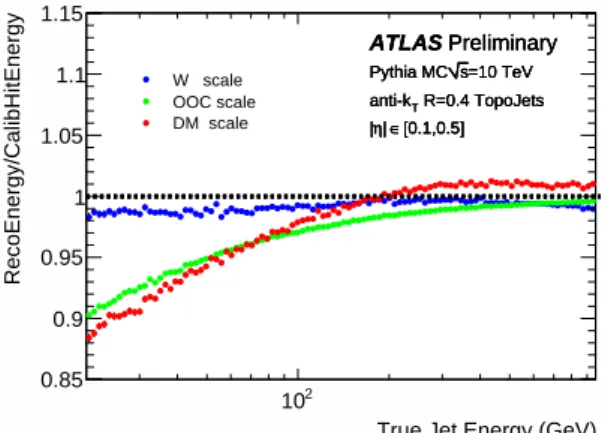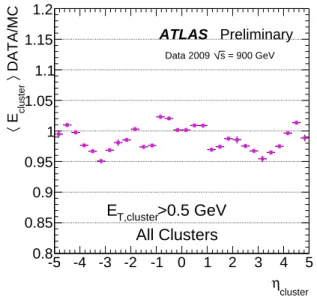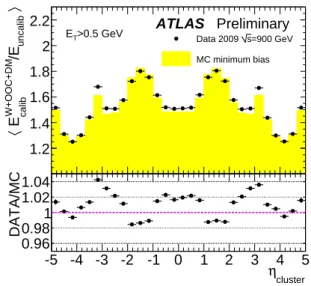This article has been downloaded from IOPscience. Please scroll down to see the full text article.
2011 J. Phys.: Conf. Ser. 293 012057
(http://iopscience.iop.org/1742-6596/293/1/012057)
Download details:
IP Address: 134.107.20.112
The article was downloaded on 22/08/2011 at 17:55
Please note that terms and conditions apply.
View the table of contents for this issue, or go to the journal homepage for more
Local hadron calibration with ATLAS
Paola Giovannini, on behalf of the ATLAS Liquid Argon Calorimeter Group
Max-Planck-Institut f¨ ur Physik, Werner-Heisenberg-Institut, F¨ ohringer Ring 6, D-80805 M¨ unchen, Germany
E-mail: paola@mppmu.mpg.de
Abstract.
The method of Local Hadron Calibration is used in ATLAS as one of the two major calibration schemes for the reconstruction of jets and missing transverse energy. The method starts from noise suppressed clusters and corrects them for non-compensation effects and for losses due to noise threshold and dead material. Jets are reconstructed using the calibrated clusters and are then corrected for out of cone effects. The performance of the corrections applied to the calorimeter clusters is tested with detailed GEANT4 information. Results obtained with this procedure are discussed both for single pion simulations and for di-jet simulations. The calibration scheme is validated on data, by comparing the calibrated cluster energy in data with Mote Carlo simulations. Preliminary results obtained with √
s = 900 GeV collision data are presented. The agreement between data and Monte Carlo is within 5% for the final cluster scale.
1. Introduction
Precise measurement of the energies of jets is fundamental for many different physics analyses foreseen with the ATLAS detector [1]. In particular the jet energy scale uncertainty is one of the largest systematic errors on the measurement of the top quark mass and of the inclusive jet cross section, which are important steps towards new physics searches.
Jet calibration can be generally viewed as consisting of two phases. In the first phase the measured signal is corrected for detector effects and out of cone effects. This calibrates the measured jet to the particle level, which is defined as the corresponding jet obtained by running the same jet algorithm on the final state particles. In the second phase the jet energy is calibrated to the parton level.
The local hadron calibration is a complete approach to the first phase of jet calibration. In this scheme detector effects are corrected at cluster level, before any jet reconstruction. This provides a consistent calibration of all calorimeter signals, which can be used as input to missing transverse energy reconstruction as well. Clusters are obtained from calorimeter cells using a three dimensional topological algorithm, which suppresses noisy cells [2]. The energy of the input clusters is defined to be at the electromagnetic scale (EM) and includes compensation for sampling fraction losses optimized for electrons and photons. The local hadron calibration consists of four steps of corrections that are based on cluster shape variables, cluster energy and cluster pseudo-rapidity (η = − ln(tan(θ/2)), θ being the angle from the beam axis) [3]:
(i) classification step: clusters are classified as stemming mainly from an electromagnetic or an
(GeV)
truth
E
10
210
30.75 0.8 0.85
ATLAS
jets, reconstructed from local hadron cali- brated clusters (E
jet), with respect to K
T(R=0.6) jets from Monte Carlo final state particles (E
truth). The jet energy response is shown over the whole energy range for three different pseudo-rapidity regions. [1]
hadronic type of shower, each of the next three corrections differ for electromagnetic and for hadronic clusters;
(ii) hadronic weight step (W): clusters that are classified as hadronic receive a correction that recovers for invisible and escaped energy;
(iii) out of cluster step (OOC): clusters are corrected for the energy discarded by the clustering algorithm because of noise thresholds;
(iv) dead material step (DM): clusters are corrected for the energy lost outside the active calorimeter volumes.
The energy scale of jets reconstructed from local hadron calibrated clusters is still lower than the energy scale of jets from Monte Carlo final state particles, as shown in Figure 1. Cluster corrections cannot account for the so called out of cone effects, like energy lost by particle never reaching the calorimeter or jet-algorithm inefficiencies. In order to take into account these effects, dedicated jet level corrections, based on jet shape variables, jet energy and jet pseudo- rapidity have been developed. After this final calibration step the energy of the jets is correctly reconstructed with respect to the final state particle jets within less than 1% [4].
2. Local correction performance
A comparison to the particle jet level is not sufficient to evaluate the performance of the cluster corrections. In order to be able to disentangle effects due to the different calibration steps it is necessary to define a true cluster energy, for each of the cluster energy scales. This definition is possible using GEANT4 [5] shower simulations. In the ATLAS simulation framework GEANT4 information is organized in terms of so called calibration hits. A calibration hit can be seen as a true calorimeter cell or as true dead material deposit, depending on where the energy is released.
The calibration hit energy is accessible for both active (liquid argon, scintillator) and inactive (absorber) material. For each reconstructed cluster the true cluster energy is then defined:
• at the hadronic scale as the sum of the energy of the calibration hits inside the cluster;
• at the out of cluster scale as the sum of the energy of the calibration hits near to the cluster, not included into any other cluster and deposited inside the active calorimeter regions;
• at the dead material scale as the sum of the energy of calibration hits near to the cluster, deposited in dead material regions;
The assignment of calibration hits to the out of cluster and dead material scale is performed via an algorithm that takes into account the proximity of the calibration hit to the cluster in η − φ space and the energy of the cluster (φ being the azimuthal angle measured around the
2
True Pion Energy (MeV)
10
410
510
6RecoEnergy/CalibHitEnergy
0.85 0.9 0.95 1 1.05 1.1 1.15
W scale OOC scale DM scale
ATLAS Preliminary Single Pion Simulation
[1,2000] GeV
∈
Pion Energies
[0.2,0.4]
∈ η
|
| W scale
OOC scale DM scale
ATLAS Preliminary Single Pion Simulation
[1,2000] GeV
∈
Pion Energies
[0.2,0.4]
∈ η
|
| W scale
OOC scale DM scale
ATLAS Preliminary Single Pion Simulation
[1,2000] GeV
∈
Pion Energies
[0.2,0.4]
∈ η
|
|
Figure 2. Linearity for the three cluster calibration correction steps with respect to true cluster energy, for single pion simulation.
The hadronic weighting step L
Wis shown in blue, the out of cluster step L
OOCin green and the dead material step L
DMin red. The performance is shown for the central region.
True Jet Energy (GeV) 10
2RecoEnergy/CalibHitEnergy
0.85 0.9 0.95 1 1.05 1.1 1.15
W scale OOC scale DM scale
ATLAS Preliminary
=10 TeV s Pythia MC
R=0.4 TopoJets anti-k
T[0.1,0.5]
∈ η
|
| W scale
OOC scale DM scale
ATLAS Preliminary
=10 TeV s Pythia MC
R=0.4 TopoJets anti-k
T[0.1,0.5]
∈ η
|
| W scale
OOC scale DM scale
ATLAS Preliminary
=10 TeV s Pythia MC
R=0.4 TopoJets anti-k
T[0.1,0.5]
∈ η


